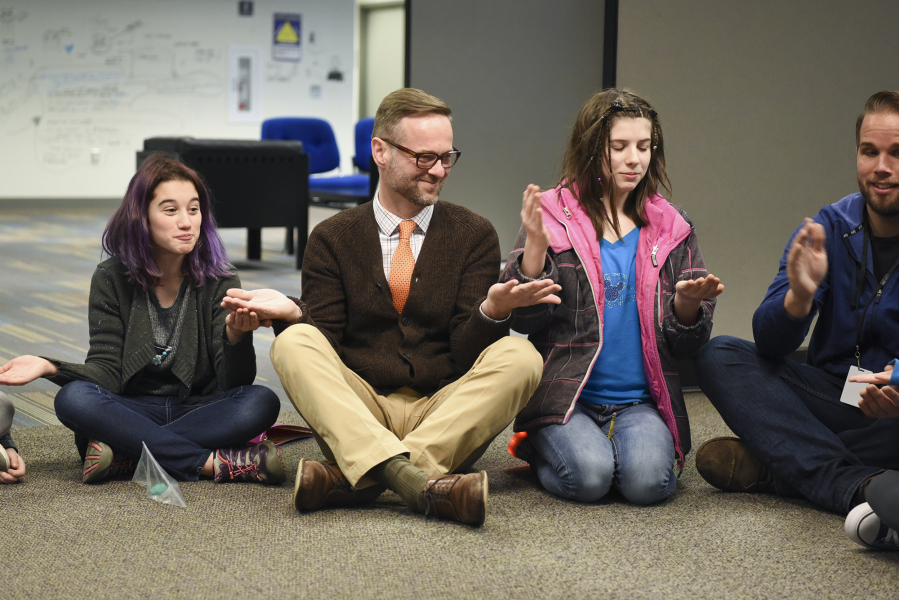Aaron Smith’s favorite memory of his two-year stint teaching music at the American Community School of Athens, Greece, isn’t his apartment at the foot of the Acropolis, although that was certainly a perk. It isn’t the travel or going on an adventure to a new country alone.
It was that the K-12 school had about 700 students from all over the world, and the relatively small student body allowed him to get to know his students and learn about their cultures.
“I grew up in Lynden, which was a small town, and didn’t have a lot of exposure to people from other backgrounds and religions and cultures,” Smith said. “Just that part alone — getting to build relationships with people from all sorts of backgrounds and perspectives — really opened my mind to other people’s experiences, which I think serves me well as a school administrator.”
Smith is now principal of the Camas School District’s project-based learning campus, which kicked off with the opening of the Camas Project-Based Learning Middle School in September. A project-based learning high school will open on the campus for the start of the 2018-2019 school year. In the program, students use more hands-on projects to collaborate on complex questions, problems and address real-world issues.
“Aaron was instrumental in shaping the vision for our Project Based Learning campus,” Camas Superintendent Jeff Snell wrote in an email. “He spent a lot of time researching what kind of model might serve our students best. Building a new program requires vision, organization and persistence. Aaron demonstrates each of these traits daily in service of students.”
The new campus has a bit in common with Smith’s years in Greece.
Its students come from a variety of educational backgrounds.
“We have kids who are identified as highly capable. We have students on IEP (Individualized Education Programs),” Smith said. “I strongly believe this is a program that can work for any student, and we have a wide variety of them here.”
It also put Smith back in a school with a smaller number of students; there are 112 sixth- and seventh-graders at the Camas Project-Based Learning Middle School. Prior to leading the new campus, Smith spent nine years as principal of Skyridge Middle School, with around 900 students.
“I didn’t have the chance to really develop relationships with students like I would like,” he said. “I missed that. In this program, with 112 kids, I’m really getting to know them and I love that.”
One reason Smith felt an entire project-based learning program could work wasn’t something he learned abroad, though. It was something he learned in Lynden: a love of music.
Smith grew up singing and playing piano, performing with family and eventually studying saxophone and bassoon as a music major at Washington State University. Smith and his aunt used to travel around Northwest Washington performing. Smith, who said he wasn’t the most engaged student in high school, took to music because he enjoyed the process of creating something.
“I was drawn to music education not only because of my experience in music with my family, but also because that’s what I connected to in school,” Smith said. “That’s where I felt the most at home, and that’s where I have all those long-lasting memories because it was something that was real experiential and also involved emotion, creativity and working as a team.”
Smith has held onto the mentality during his 20-plus years as an educator, and it’s something he’s looking to share with the project-based learning students at his new campus.
“Aaron has a joy for life that spills into everything he does,” Snell wrote. “He is centered on students and wants to create learning that’s challenging and fun. I’ve learned a lot from Aaron about leadership and aligning your passion to your work.”
Chasing challenges
One of the big challenges of starting up a new program, Smith said, was educating the public on project-based learning, in which students use more hands-on projects to collaborate on complex questions, problems and address real-world issues.
“The world has completely changed from when we were in school, and we owe it to our kids to prepare them for today,” Smith said. “Things will change again. I’m very proud to be a public educator. I’m very proud of our district. Teachers work so hard everywhere, and I’m thrilled to be part of this with such a great team to try something a bit different.”
Another difficulty Smith and his staff faced was getting everything ready for the new school. The district purchased the former 55,000-square-foot Sharp Laboratories of America building and 31.57 acres of surrounding property for $12.5 million in July, leaving less than two months to get ready to open a new middle school for 112 sixth- and seventh-graders. The old Sharp building was move-in ready, which helped, as district officials scrambled to set up the second floor of the building to get most use out of the space.
“I have always enjoyed challenging the status quo and being an out-of-the-box thinker,” Smith said. “This was a perfect storm of community support and interest, the support from our superintendent and the school board, and it all came together really quickly. It’s a great opportunity for kids to not only work on content, but to develop those 21st century skills of collaborating, communicating, critical thinking and creativity.”
Since getting in the middle school, there has been an adjustment period while teachers find the proper mixture of project work and more traditional instruction. Smith said students receive direct instruction in math every day, and teachers now use an online format i-Ready that allows teachers to create specialized playlists so students can work on specific skills at their own pace.
The middle school program will expand next school year to include eighth-graders, and ultimately, the middle school will serve 380-400 students, Smith said. The high school project-based learning program will house around 600 students.
Smith and district officials are currently designing the new high school, and he said he doesn’t want it to feel like a school. He wants it to feel like a professional environment, as well as a learning one.
“I want it to be a space that inspires creativity and inspires kids to imagine their futures and to see they can do anything,” Smith said.
The middle school hadn’t had many discipline problems as of winter break, and Smith thought it was because the students are more engaged. The school asked students to fill out a survey around the midpoint of the year, and 92 percent of students said they were more excited to come to school this year than previous years.
After living through No Child Left Behind, Smith is starting to see a shift from the era of “super high accountability.”
“It’s not one big test at the end of the year and then looking at it the next year as more of an autopsy,” Smith said. “What we want to do is we want to be diagnostic along the way, so that it informs us so we know how to best support our students and teachers.”
Smith is happy about that, because he felt the No Child Left Behind era — which he said had some positive outcomes — ended up adding too much stress to students, parents and teachers.
“We’re coming back to a healthier balance of educating the whole child and going back to those opportunities where there are makerspaces and when there’s music and giving kids the opportunity to address their passions and their heart, in addition to the content,” Smith said. “We’re getting better at making those connections for kids. The world isn’t segregated into different little subject areas. Everything is connected.”




